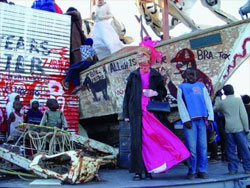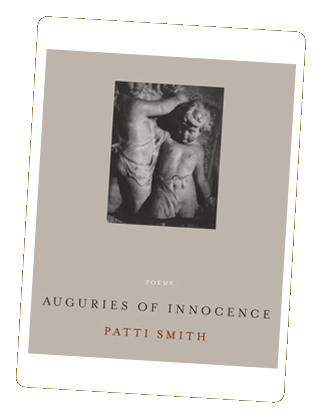 |

|
an
interview with page six TODD BAESEN: You recently visited Africa to play your clarinet in a neo-dadaist film, The African Twin Towers, directed by Christoph Schlingensief.
PATTI SMITH: Yes, I was in Namibia, but I was there as an amateur, because I'm not an actress, and I don't even know exactly what everyone was doing, I just had a belief in it and I wanted to be part of the common energy. I spent most of my time using my camera to take Polaroid's of the work process, and of the earth and the people. Then while I was up near the Angola border, I was in a tent one night with heavy mosquito netting and I woke up around 2:00 in the morning to go to the bathroom, and in the middle of this very eloquent squat, I noticed the moon through the mosquito netting. It was very full and blue so I thought, "that's really pretty, the moon is blue in Africa." Then I realized that the moon wasn't full, because it had been full a week ago, and there are no street lamps, so what was this? Then I saw another golden thing in the sky and I wanted to inspect what it was, so I unzipped my tent and sitting there was the biggest, ugliest frog I'd ever seen. I thought, "if I step on this, the wart will be so big!" so I said, "get away," and I started playing my clarinet at it... my legendary playing that will send animals flying. Then I went outside the tent and it was really dark, with trees everywhere so I couldn't really see the sky. I had to walk around to get a clearer view and you wouldn't believe what I saw. I can't imagine any acid trip being better than this, but this is a true story. I could see the curve of the earth and the sky with millions of stars in it, but also this round blue globe that was Venus, and it looked like a small moon. Then there was a smaller golden-yellow star that was Mars and a third planet that was even smaller, that could have been Saturn. It was really beautiful, and it was really there and I just stood there and thought, "Oh my God!" I was by myself and it was so overwhelming, I yelled out, "help!" before I realized it was coming out of my mouth. I don't know why I did that, because there was nobody around. But it was truly one of nature's wonders, nature giving us her opera. TODD BAESEN: That's quite an interesting thing to ponder, because the moon and stars have inspired artists throughout the centuries, and in The Pythagorean Traveler you note that Lord Byron was seeing the same moon, ocean and clouds in Italy that we still see today, which made me think about all the historical people who were inspired by the Moon and the stars, from Pythagoras and Jesus Christ, up through William Blake and Pablo Picasso. PATTI SMITH: Yes, and not only those things but also all of the other rare celestial phenomenon that take place, such as the transit of Venus. Before last year, the last transit of Venus occurred in the winter of 1882 and it was most certainly witnessed by Arthur Rimbaud, as he paddled his intoxicated craft through the Milky Way. TODD BAESEN: I see you've contributed an essay to this new book Jerry Garcia: The Complete Artwork. PATTI SMITH: Yes, I actually forgot I had written something for it, but it's a really nice book of Jerry's paintings. I think Jerry would have been very proud of it. TODD BAESEN: Of course, Jerry Garcia was the inspiration for your song Grateful. PATTI SMITH: Well, I hate to be redundant and I've told that story many times. Actually, my mother was really good at telling stories, because even if she told the same story over and over, she always told it from a slightly different angle and with so much enthusiasm, that you always felt like you were hearing that old Nat King Cole story for the first time. TODD BAESEN: What Nat King Cole story was that?
PATTI SMITH: Well, my mom was a really good jazz singer in the thirties, long before we were born. She had this great voice, but it was destroyed by cigarettes and she got throat cancer. It didn't take her down; it just took her voice down. She doubled as a hatcheck girl and a singer. And one day these Mafia guys took a liking to her and said they were going to take her down to Atlantic City, where they were taking a look at a piano player at one of their clubs. So they went to Atlantic City and my mom went into this club and said the piano player was one of the ugliest fellows she ever saw. So she listened to him play and she said he was really good, that he just radiated a specific kind of confidence. So after about an hour, it was about 2:00 in the morning and people started drifting away, and he started singing. He sang some little song, like Tangerine, and my mother said to him, "what are you doing playing piano for, you should be singing. You're one of the greatest singers I ever heard." He was very self-effacing and said, "oh, no I'm just a piano player." She said, "No, you're a fantastic singer!" Then, later on, this guy she said was the ugliest person she ever saw, ended up becoming Nat King Cole. TODD BAESEN: So you mother encouraged both you and Nat King Cole to become singers! PATTI SMITH: Yeah, and I can clearly remember my mother's voice when she sang to us, putting us to sleep, and my father whistling Deep Purple. I also remember my first gramophone. It was just a little bigger than a shoebox. My first two records were, Tuby the Tube and Big Rock Candy Mountain. I loved to watch them whirl while I was dreaming. Then, when I was 9, my family moved to South Jersey and my music teacher loved Opera. He would bring these albums to class and play Verdi and Puccini. I was also really impressed by the singing of Maria Callas-her emotional intensity and depth. At that time I was dreaming that I would become an opera singer-but I just didn't have the talent for it, the body structure or the needed discipline. Later on, I dreamed of becoming a jazz singer, like June Christie or Billie Holiday, with a mournful voice. But the song that left the greatest impression on me, that fascinated me the most, was Tutti Frutti by Little Richard. That's how rock and roll was born in my life. But I never ever dreamed that I'd be singing in a rock and roll band. Anyhow, the Jerry Garcia story happened when I was living in Michigan and various things were occurring in my life and I was a little blue. My hair was starting to turn gray, and I knew I would get old, but watching one's hair turn different colors is weird. So I went to the doctor and said, "something's wrong with my hair. I think I have iron deficiency anemia or something, my hair's turning silver." The doctor said, "yes, it's called getting old." So I was having a bad laundry day, and feeling a little down, and all of a sudden out of nowhere I saw this vision of Jerry. I know this sounds like people who say they see Jesus in a potato chip, but this actually happened. I saw a distinct vision of Jerry just smiling at me with a twinkle in his eye. Then right after that, this little song came into my head. I don't write that many songs by myself, but this whole song just came into my head, so I sat down and writ it and when I was done, I decided because Jerry seemed to give it to me, that I'd call it Grateful. And as I've often said, I truly am. TODD BAESEN: Since you wrote such a beautiful piece for the Jerry Garcia book, I think it's appropriate that we include an excerpt from it here:
|
|



